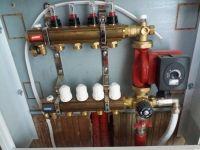Hello,
I am asking for help in the following matter, in my two-story house with an attic, I have floor heating downstairs, in the upper corridor and in the bathrooms, while in the upper rooms heaters controlled manually. The plumber said I would have one floor controller in the room upstairs. As I talked with friends, they have such controllers in each room with a temperature sensor. I returned to the plumber with it and he says that since there is a floor and heaters, one sensor is enough and it must be in a room where there is NO floor.
I don't know anything about it, but it's logical to think it's better for the oven controller to calculate something like an average than to operate on the basis of data from one point. What, for example, when in this room where the sensor is open a window is opened in winter and let's forget to close it for the whole day?
The heating is gas on a condensing boiler with a DHW tank, 2 floor distributors at the bottom, radiators at the top, at the floor distributor there is a pump and probably a four-way valve. The house is small, 98 sq m, please advise how to control it according to the art.
I am asking for help in the following matter, in my two-story house with an attic, I have floor heating downstairs, in the upper corridor and in the bathrooms, while in the upper rooms heaters controlled manually. The plumber said I would have one floor controller in the room upstairs. As I talked with friends, they have such controllers in each room with a temperature sensor. I returned to the plumber with it and he says that since there is a floor and heaters, one sensor is enough and it must be in a room where there is NO floor.
I don't know anything about it, but it's logical to think it's better for the oven controller to calculate something like an average than to operate on the basis of data from one point. What, for example, when in this room where the sensor is open a window is opened in winter and let's forget to close it for the whole day?
The heating is gas on a condensing boiler with a DHW tank, 2 floor distributors at the bottom, radiators at the top, at the floor distributor there is a pump and probably a four-way valve. The house is small, 98 sq m, please advise how to control it according to the art.



